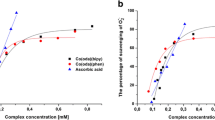Abstract
The mechanisms of toxicity to isolated rat hepatocytes of Fe(II) and Fe(III) complexes of two structurally related naphthoquinones have been studied. All complexes were found to show a dose-dependent toxicity which precedes cell death. Within the naphthoquinone series the order of toxicity is Fe(II) > parent naphthoquinone > Fe(III). The iron complexes of 5-OH-1,4 naphthoquinone (5-OH-1,4 NQ; Juglone) are more toxic than the iron complexes of 2-OH-1,4 naphthoquinone (2-OH-1,4 NQ; Lawsone) indicating that the mechanisms of toxicity are different. Electrochemical studies on these complexes shows that 5-OH-1,4 NQ facilitates formation of stable semiquinone species while 2-OH-1,4 NQ does not. The low redox potential of 2-OH-1,4 NQ makes it a poor substrate for metabolism by reductases.
Similar content being viewed by others
References
Arcamone F. 1981Doxorubicin: Anticancer Antibiotics. New York: Academic Press.
Aust SD, Miller DM. 1990 In:Role of Iron in Oxygen Radical Generation and Reactions. Lilly Research Laboratories Symposium. Lilly Research Foundation. Indianapolis, USA.
Bottei RS, McEachern CP. 1970 Thermal and spectral studies of some metal chelates of lawsone and juglone.J Inorg Nucl Chem 32, 2653–2663.
Carter SK. 1975 Adriamycin—a review.J Natl Cancer Inst 55, 1265–1274.
Carter SK, Crooke S, eds. 1979Mitomycin C: Current Status and New Developments. New York: Academic Press.
Di Monte D, Ross D, Bellomo G, Eklow L, Orrenius S. 1984a Alterations in intracellular thiol homeostasis during metabolism of menadione by isolated rat hepatocytes.Arch Biochem Biophys 235, 334–342.
Di Monte D, Bellom G, Thor H, Nicotera P, Orrenius S. 1984b Menadione-induced cytotoxicity is associated with protein thiol oxidation and alteration in intracellular Ca2+ homeostasis.Arch Biochem Biophys 235, 343–350.
Doherty D'Arcy M, Cohen GM, Smith MT. 1984 Mechanisms of toxicity of 2- and 5-hydroxy 1,4 naphthoquinones; absence of redox cycling in the toxicity of 2-hydroxy 1,4 naphthoquinone.Biochem Pharmacol 33, 543–549.
Ernster L. 1984 Biochemistry of oxygen toxicity. In: Ovchinnikov YuA, ed.,Progress in Bioorganic Chemistry and Molecular Biology. Amsterdam: Elsevier Science Publishers B.V. 303–309.
Guajardo RJ, Mascharak PK. 1995 Lipid peroxidation by synthetic analogues of iron-bleomycin: possible role of a low-spin {hydroperoxo}iron(III) intermediate in lipid peroxidation induced by bleomycin.Inorg Chem 34, 802–808.
Halliwell B, Gutteridge JMC. 1984 Oxygen toxicity, oxygen radicals, transition metals and disease.Biochem J 219, 1–14.
Jasiatis RG, Krantz A. 1972 Juglone: an organic chemistry-ecology interaction experiment.J Chem Ed 49, 436–437.
Joshi CR. 1975 Metal chelates of juglone.PhD Thesis, University of Pune.
Kumbhar A, Padhye S, Saraf A, Mahajan H, Chopade B, West D. 1991 Novel metal-based antifungal agents. Correlation amongst the structural and biological properties of copper(II) 2-acetyl-pyridineN-dialkyl thiosemicarbazones.Biol Met 4, 141–143.
Lal JB, Dutt S. 1933 Constitution of the colouring matter ofLawsonia alba, or Indian Mehendi.J Indian Chem Soc 10, 577–579.
Moldeus P, Holbert J, Orreneius S. 1978 In: Feischer S, Packer L eds.Methods in Enzymology 52, New York: Academic Press; 60–71.
Morton RA. 1965.The Biochemistry of Quinones. New York: Academic Press.
Padhye S, Kulkarni BA. 1975a H-bonding interaction of some naturally occurring isomeric juglones with dioxane.J Phys Chem 79, 927–928.
Padhye S, Kulkarni BA. 1975b Evidence for the hydrogen bonding in some hydroxylated naphthoquinones by adsorption.Chromatographia 8, 352–353.
Pinkus R, Weiner LM, Daniel V. 1995 Role of quinone-mediated generation of hydroxyl radicals in the induction of glutathione S-transferase gene expression.Biochemistry 34, 81–88.
Reed DJ, Babson JR, Beatty BW, Brodie AE, Ellis WW, Porter DW. 1980 High performance liquid chromatographic analysis of nanomole levels of glutathione, glutathione disulfide, and related thiols and disulfides.Anal Biochem 106, 55–62.
Ross D, Thor H, Orrenius S, Moldeus P. 1985 Interaction of menadione (2-methyl-1,4 naphthoquinone) with glutathione.Chem-Biol Interact 55, 177–184.
Soderquist CJ. 1973 Juglone and Allelopathy.J. Chem Ed 50, 782–783.
Thompson RH. 1971Naturally Occurring Quinones. New York: Academic Press.
Young RC, Ozols RF, Myers CE. 1981 The anthracycline antineoplastic drugs.New Engl J Med 305, 139–153.
Author information
Authors and Affiliations
Rights and permissions
About this article
Cite this article
Kumbhar, A., Padhye, S. & Ross, D. Cytotoxic properties of iron-hydroxynaphthoquinone complexes in rat hepatocytes. Biometals 9, 235–240 (1996). https://doi.org/10.1007/BF00817921
Received:
Accepted:
Issue Date:
DOI: https://doi.org/10.1007/BF00817921




